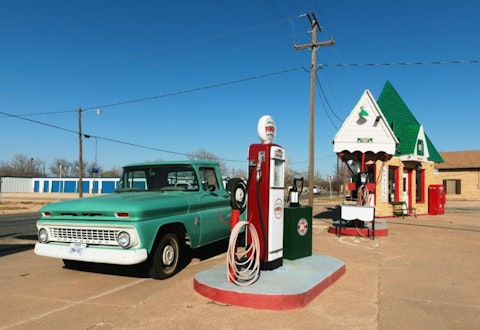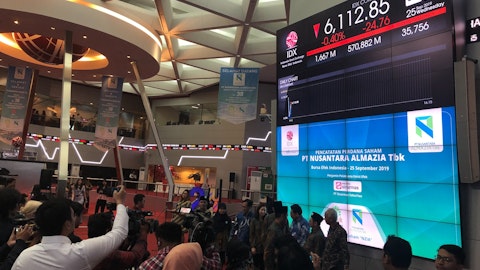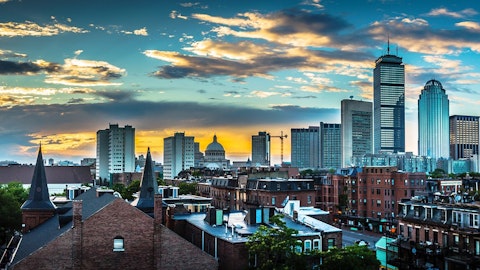In this article, we will be looking at the 15 poorest cities in the US that are actually growing fast. You can skip our detailed analysis and head directly to the 5 Poorest Cities in the US that are Actually Growing Fast.
Poverty in the US: An Analysis
The United States is on the verge of being replaced by China as the largest economy in the world. China is expected to be the largest economy in the world by 2040 with a forecasted real GDP of $34.10 trillion. The United States will drop to the second spot with a forecasted real GDP of $32 trillion. Though economic power is transferring from the US to China, the land of opportunities will remain an important player in the global economy. In September 2023, the US Census Bureau posted a poverty report in which it highlighted that the official poverty rate of the US in 2022 was 11.5%, representing approximately 37.9 million people in poverty. The poverty rate in the US was not much different from 2021, which was 11.6% that year. The supplemental poverty measure (SPM) soared to 12.4% in 2022, a rise of 4.6% from 2021. The increase in the SPM rate was the first since 2010. The official poverty rate remains higher than in the pre-pandemic era when it was 10.5% in 2019. Between 2021 and 2022, most of the demographic groups in the US did not experience significant changes in their poverty rates. Black individuals saw a decline in their official poverty rate between 2021 and 2022, dropping from 19.5% to 17.1%. While, the White and non-Hispanic White people both saw a 0.5% increase in their official poverty rate, jumping from 10% to 10.5% and 8.1% to 8.6% between 2021 and 2022, respectively.
Overall, the US has a diverse economy with various demographics and income brackets. According to the World Inequality Database, almost 20% of the US national income goes to the richest 1% of the population and nearly 50% of national income goes to the top 10%. The US states where the poverty rates are the lowest are a mix of the country’s demographics including the Northeast region and some from the Midwest and West. New Hampshire is the state with the lowest poverty rate of 7.2%, as per the Census Bureau’s 2022 American Community Survey. New Hampshire’s poverty rate has gone down by 28% from 10% to 7.2% in the last decade. Utah makes it to the second spot with the lowest poverty rate, with only 8.2% of its people living below the poverty line. The US states with the highest poverty rates are mostly Southern states, and some exceptions such as New York and New Mexico. Mississippi has the worst poverty level, where 19.1% or almost one-fifth of the population were living below the poverty line in 2022. The good thing is that Mississippi has experienced an improvement, over its 21.5% poverty rate in 2017.
The poorest cities in the US that are actually growing fast may allow you to get into the real estate market when the market is really cheap. For instance, Fort Worth, Texas, is a buyer’s market at the moment, according to the real estate listing platform, Realtor. The median listing home price in Fort Worth was $342,000 in January, falling by 2.5% year-over-year. This means that the supply of homes is greater than the demand for homes. Similarly, the real estate market in Phoenix, Arizona, is expected to grow by 3.2% by September 2024, as per Norada Real Estate Investments.
The 2024 housing market seems more optimistic following the Fed’s recent meetings in December and January. Mortgage rates have gone down from 8% to 6.6%. According to CoreLogic, 2024 began with more new listings compared to 2023, showing potential demand for homebuyers as they step off the sidelines. The increase in buyer demand for homes will continue to outweigh the available supply, leading to an increase in home prices. CoreLogic’s Home Price Index (HPI) forecast expects home prices to increase by 3% on average in 2024.
Real Estate Players in the US
Equity Residential (NYSE:EQR), AvalonBay Communities, Inc. (NYSE:AVB), and Invitation Homes Inc. (NYSE:INVH) are some of the leading residential REITs in the US.
Equity Residential (NYSE:EQR) is one of the leading real estate companies that invests in apartments and housing facilities. On January 30, Equity Residential (NYSE:EQR) announced the fourth quarter results for 2023. The company posted earnings per share of $0.82, beating consensus estimates by $0.39. Equity Residential (NYSE:EQR) reported a revenue of $727.50 million, surpassing estimates by $2.62 million. Here are some of the comments from the Q4 2023 earnings call:
“On the revenue side, the momentum in December was a little better than we thought as sequentially we grew revenue in the fourth quarter by holding onto more occupancy, while maintaining positive blended rate growth.
This set us up for a good start in 2024. Demand was solid across our markets and consistent with seasonal expectations. We finished the year with same store physical occupancy at 96% as we focused on building up occupancy in the slower part of our leasing cycle. Today, the portfolio is above 96%. As expected, we saw new lease rates go negative in the quarter as they typically do. Meanwhile, renewal rates for the quarter came in at 5.1%, which was slightly above our expectations. Together, this resulted in a fourth quarter blended rate growth of positive 80 basis points. These healthy fundamentals led to outstanding revenue growth in our East Coast markets and good growth in Southern California. As has been the case all year, the East Coast markets outperform the West Coast and by and large will likely continue to do so in 2024.”
Invitation Homes Inc. (NYSE:INVH) is one of the largest owners of single-family rental homes in the US. On January 10, Invitation Homes Inc. (NYSE:INVH) announced that it would begin offering professional property and asset management services to portfolio owners of single-family homes for lease. Through an inaugural agreement with a third-party portfolio owner, Invitation Homes Inc. (NYSE:INVH) will bring more than 14,000 single-family homes onto the company’s industry-leading platform.
AvalonBay Communities, Inc. (NYSE:AVB) is a top REIT that invests in the housing sector. On January 31, AvalonBay Communities, Inc. (NYSE:AVB) announced its fourth quarter results for 2023. The REIT posted earnings per share of $1.70, surpassing the estimates by $0.37. The company’s revenue came in at $702.70 million, beating consensus by $2.54 million. AvalonBay Communities, Inc. (NYSE:AVB) was able to make profitable investments in 2023 and entered with the same momentum in 2024. Here are some of the comments from the Q4 2023 earnings call:
“We also started $800 million of profitable new development during the year, including $300 million of starts in the fourth quarter at an initial projected yield of 6.7%. We also continue to build our structured investment business this year, in which we provide preferred equity or mezzanine loans to third parties for new multifamily construction. We’re well positioned to underwrite this business given our development and construction expertise and our live proprietary data and we’re fortunate to be building this book of business in today’s environment, reflecting today’s rates and asset values.”
These were a few of the biggest residential real estate companies in the US. Now, let’s take a look at the poorest cities in the US that are actually growing fast.

15 Poorest Cities in the US that Are Actually Growing Fast
Our Methodology
First, we shortlisted the cities with a minimum population of 500,000. Then we narrowed down our list of the cities with positive population growth between 2020 and 2022. We did not consider cities with a median household income greater than $90,000 and a poverty rate of less than 10%. The cities are ranked based on their percentage change in population between April 1, 2020, and July 1, 2022, in ascending order. All the data including population, median household income, and poverty rate was gathered from the US Census Bureau‘s database.
By the way, Insider Monkey is an investing website that tracks the movements of corporate insiders and hedge funds. By using a consensus approach, we identify the best stock picks of more than 900 hedge funds investing in US stocks. The top 10 consensus stock picks of hedge funds outperformed the S&P 500 Index by more than 140 percentage points over the last 10 years (see the details here). Whether you are a beginner investor or a professional one looking for the best stocks to buy, you can benefit from the wisdom of hedge funds and corporate insiders.
Note: There were cities with low median household incomes and greater poverty rates, but we did not consider them due to their population decline between April 1, 2020, and July 1, 2022.
15 Poorest Cities in the US that Are Actually Growing Fast
15. Houston, Texas
Change in Population in 2022: 0.01%
Population in 2020: 2,301,572
Population in 2022: 2,302,878
Poverty Rate in 2022: 19.60%
Median Household Income in 2022: $60,440
Houston, Texas, is one of the poorest cities in the US that are actually growing fast. Houston’s population increased by 0.01% between 2020 and 2022.
14. Columbus, Ohio
Change in Population in 2022: 0.23%
Population in 2020: 905,839
Population in 2022: 907,971
Poverty Rate in 2022: 18.10%
Median Household Income in 2022: $62,994
Columbus, Ohio, has a poverty rate of 18.10%, as of 2022. Columbus’ population increased by 0.23% between 2020 and 2022.
13. Kansas, Missouri
Change in Population in 2022: 0.30%
Population in 2020: 507,971
Population in 2022: 509,297
Poverty Rate in 2022: 14.90%
Median Household Income in 2022: $65,256
Kansas, Missouri, witnessed a population growth rate of 0.30% between 2020 and 2022. Kansas has a poverty rate of 14.90% and a median household income of $65,256.
12. Sacramento, California
Change in Population in 2022: 0.60%
Population in 2020: 524,924
Population in 2022: 528,001
Poverty Rate in 2022: 14.80%
Median Household Income in 2022: $78,954
Sacramento, California, has a poverty rate of 14.80%, as of 2022. Sacramento’s population increased by 0.60% between 2020 and 2022. The city is placed 12th among the poorest cities in the US that are actually growing fast.
11. Fresno, California
Change in Population in 2022: 0.61%
Population in 2020: 542,252
Population in 2022: 545,567
Poverty Rate in 2022: 22.10%
Median Household Income in 2022: $63,001
Fresno, California, had a population growth rate of 0.61% between 2020 and 2022. Fresno has a poverty rate of 22.10% and a median household income of $63,001.
10. Tucson, Arizona
Change in Population in 2022: 0.72%
Population in 2020: 542,656
Population in 2022: 546,574
Poverty Rate in 2022: 19.60%
Median Household Income in 2022: $52,049
Tucson, Arizona, has a poverty rate of 19.60%, as of 2022. The population of Tucson experienced a growth of 0.72% between 2020 and 2022. The city is ranked 10th among the poorest cities in the US that are actually growing fast.
9. Austin, Texas
Change in Population in 2022: 1.30%
Population in 2020: 961,900
Population in 2022: 974,447
Poverty Rate in 2022: 12.40%
Median Household Income in 2022: $86,556
Austin, Texas, has a median income of $86,556 and a poverty rate of 12.40%, as of 2022. With a population growth of 1.30% between 2020 and 2022, Austin is one of the poorest cities in the US that are actually growing fast.
8. Mesa, Arizona
Change in Population in 2022: 1.63%
Population in 2020: 504,300
Population in 2022: 512,498
Poverty Rate in 2022: 11.20%
Median Household Income in 2022: $73,766
Mesa, Arizona, had a population growth rate of 1.63% between 2020 and 2022. Mesa has a poverty rate of 11.20% and a median household income of $73,776.
7. Las Vegas, Nevada
Change in Population in 2022: 1.77%
Population in 2020: 644,866
Population in 2022: 656,274
Poverty Rate in 2022: 14.70%
Median Household Income in 2022: $66,356
Las Vegas, Nevada, has a poverty rate of 14.70%, as of 2022. The population of Las Vegas grew by 1.77% between 2020 and 2022. The city is placed seventh among the poorest cities in the US that are actually growing fast.
6. Oklahoma City, Oklahoma
Change in Population in 2022: 2.01%
Population in 2020: 681,084
Population in 2022: 694,800
Poverty Rate in 2022: 15.00%
Median Household Income in 2022: $64,251
Oklahoma City, Oklahoma has a poverty rate of 15% and a median household income of $64,251. Oklahoma City witnessed a population growth rate of 2.01% between 2020 and 2022.
Click to continue reading and see the 5 Poorest Cities in the US that are Actually Growing Fast.
Suggested Articles:
- 35 Top Paying Jobs in America
- 30 Fastest Growing Jobs In America
- 66 Countries with a Double Tax Treaty with the USA
Disclosure: None. 15 Poorest Cities in the US that are Actually Growing Fast is originally published on Insider Monkey.





